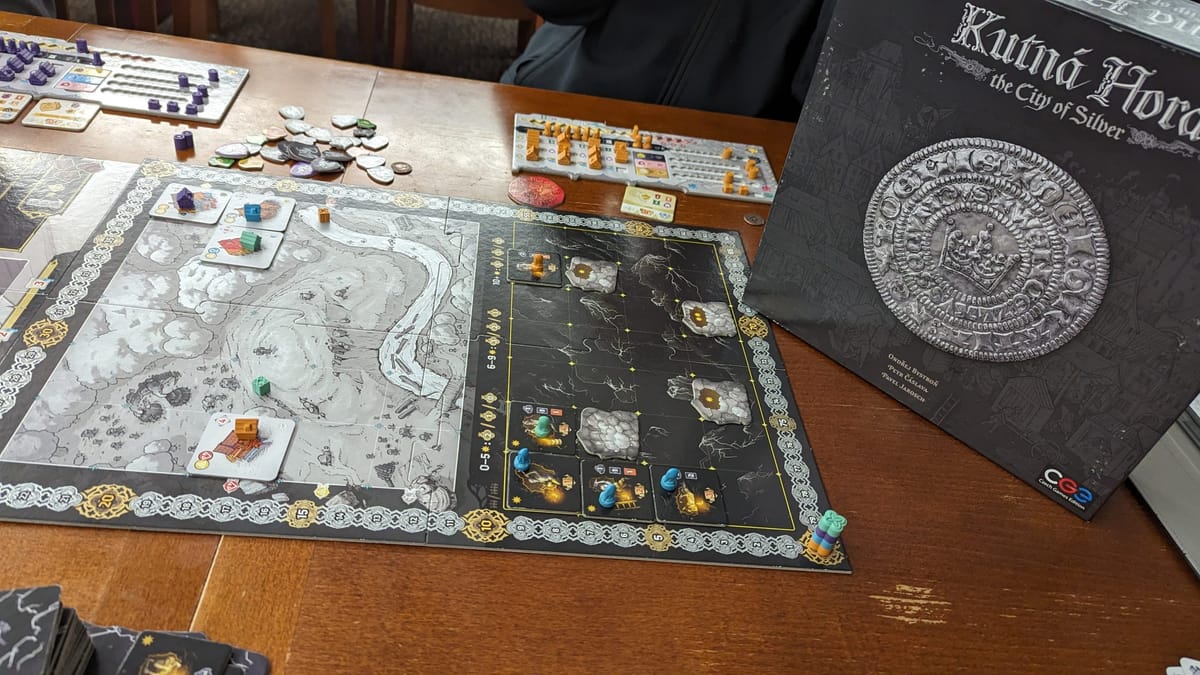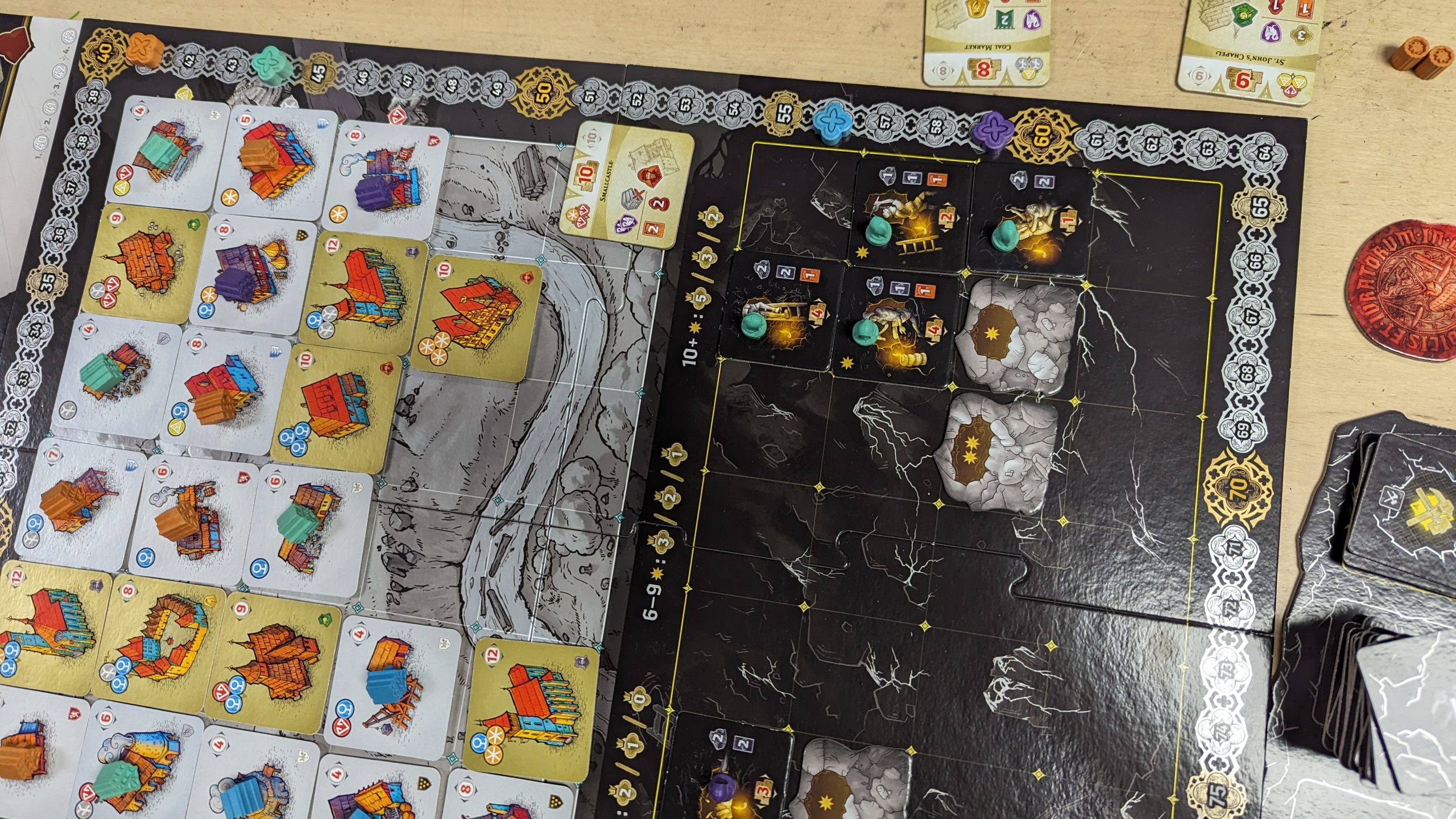
I love Brass: Birmingham. The high interactivity combined with how well it rewards tweezing out every last mote of efficiency is crazy fun. However, it’s also opaque to the point that it’s nigh unapproachable for new players. Learning the nuances of each action and its requirements alongside the minutiae of collective and personal networks means that hitting the appropriate timing to perform decently will require a fair amount of handholding. For example, you’re gonna need to take at least one loan an era, and when you should do that is a really simple call- when you’ve got nothing better to do. Problem is, a new player doesn’t have the experience to make that judgment. I could go on, but suffice to say, there’s just so much going on that most new players will not only have to take an L, but a deflatingly distant one. All that to say, I’m head over heels for Kutnà Hora because it shakes up the economic action selection euro subgenre in a way that makes it much less obtuse while not losing much of the crunch.

A big part of Kutnà Hora’s ease of onboarding is how it front loads the decision of which parts of the economy you’re going to be participating in that game. During setup, guild buildings are stuffed and then put in like stacks on the market board and a guild lots card is drawn, from which players will draft the combination of guilds they’ll have access to that game. Most of these dynamic multi-resource games leave the economy wide open at the beginning, with players only specializing over the course of the game, but Kutnà Hora is able to flatten the balance between players by restricting what they’re able to get into. Since they’ll only need to care about what their three guilds do instead of all six, players are presented with a much less daunting opening, able to do whatever strikes them at first glance with the knowledge that whatever they wind up choosing to do will be within the bonds of the lots’ balance.

Once everyone’s picked their guilds and slotted them into their player boards, you’re free to dive into the actual gameplay of Kutnà Hora. Player turns consist of playing two of your dual-use action cards to perform those actions and passing play to the next player, who does the same until you only have two cards left in your hand, at which point you’re only going to resolve one each, the round ends, you pick your cards back up and advance the round tracker, triggering certain effects based on the round number. That’s the basics, but unless you’re going heavy into mining (more on that later), you’ll be getting the majority of your points from slapping building tiles on the city board, a three-step process. Somewhere along the line, you’ll need to buy the rights to the building you want: grab the top building from a guild stack you’re affiliated with or public building you like the neighborhood icons/patrician of, pay the rights cost indicated on the bottom of its column, and rotate that stack to the most expensive slot in that row. You’re also gonna need a plot: if you do this before anyone’s erected a building in Kutnà Hora, you can nab a plot anywhere in the city for five coins, but once the city starts filling up, you’ve got to nab a plot next to an existing building. This can be cheap, since no one wants to live next to the mine vents your neighbor just built, or extremely expensive, since everyone wants a spot next to that fancy new church. Those first two can be done in any order, and one of the many things you’re doing in this game is trying to path those out optimally, but the final step of building is always, unsurprisingly, building, done by paying one of your available buildings’ wood costs multiplied by the current cost of wood, you can toss that tile into one of your plots and carry out the effects associated with it. For guild buildings, you’ll usually be increasing your personal income of the associated resource and lower its price by moving a slider or card on one of the cardboard computers and plopping the leftmost house from the guild’s track on your player board and gaining the associated benefit. Public buildings don’t have an associated resource or house track; instead, you’ll introduce a patrician for scoring alongside a bevy of neighborhood icons you’ll optimally be benefiting from more than your opponents.

While most players will have the city as the focus of their game, some will find the mines more appealing. The mine action contains a few steps: first, you can pay the cost of a permit to refresh your pool of available miners, then you draw mine tiles equal to the current technology level, pick one, place it adjacent to an entrance or pre-existing mine tile, pay the highest wood cost of adjacent tiles, slap one of your available miners onto it, and finally adjust the market and your ore production if indicated.
All this starts getting really expensive, so at some point, you’re going to need to take the income action. Income is perhaps the most straightforward action: you take your goods production, multiply it by the cost of those goods, and take that much from the bank, with the option to pay ten coins to add an unlocked patrician to the council, adding its scoring condition when patrician scoring happens. The last two actions are due to their nature the most versatile: jokers act as any action, but ding your reputation if it isn’t already high enough that you’ve unlocked free jokers.The St. Barbara action can only be used if you have an available pelican token, and consists entirely of flipping that token, building the next stage of St. Barbara, and gaining the associated benefit. These are all different enough that I’m not going to bother explaining them all here, but thankfully the player aids are top notch and explain all the iconography you’ll run across in a playthrough, functioning as a postcard-sized rulebook and strategy reference.
Quickly enough, you’ve run through all the rounds, your actions have dried up, and it’s time to enter end game scoring. You gain positive or negative points depending upon your reputation, a point for each ten income you have, neighborhood icon adjacency for buildings you own, and area majority scoring for stars in rows in the mine. It is a bit fiddly and overlong, but end loading scoring is the norm nowadays so as not to demoralize players who invest in different scoring systems.
All in all, there’s a lot to like about this game. The rulebook has to have the best formatting I’ve seen in a while, the RE-wood pieces are all a delightful combination of high detail and wood texture, the foil embossing across the production is a nice touch, the built buildings are absolutely gorgeous, and fiddling with the cardboard computers that track the markets is an absolute joy. Perhaps my favorite is the naturally tight scoring. For the only game I’ve played with a first-last spread of over ten points, the last place player was working on a half hour of sleep.
Kutná Hora: The City of Silver
Excellent
I've tried my best to find something to ding Kutnà Hora for, and the best I can think of is how bad I want an insert to streamline setup. Don't listen to the haters, this is my favorite production of the year and an absolute must for fellow economic euro fans.
Pros
- Beautiful production
- Smooth gameplay
- Tight scoring
Cons
- Setup is longer than I'd like
- End game scoring is similarly fiddly and overlong
